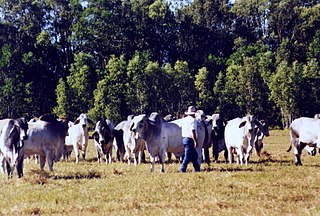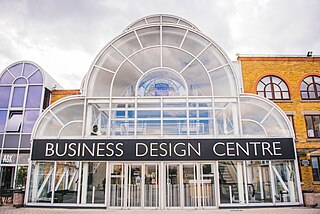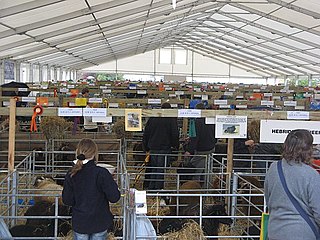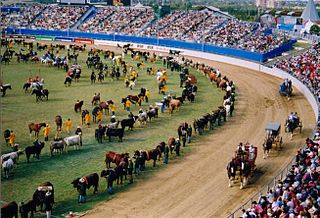
The Worshipful Company of Fishmongers is one of the 110 Livery Companies of the City of London, being an incorporated guild of sellers of fish and seafood in the City. The Company ranks fourth in the order of precedence of City Livery Companies, thereby making it one of the Great Twelve City Livery Companies.

The Metropolitan Borough of Finsbury was a Metropolitan borough within the County of London from 1900 to 1965, when it was amalgamated with the Metropolitan Borough of Islington to form the London Borough of Islington.

Royal Wootton Bassett, formerly Wootton Bassett, is a small market town and civil parish in Wiltshire, England, with a population of 11,043 in 2001, increasing to 11,385 in 2011. Situated in the north of the county, it lies 6 miles (10 km) to the west of the major town of Swindon and 10 miles (16 km) northeast of Calne.

Earls Court Exhibition Centre was a major international exhibition and events venue just west of central London. At its peak it is said to have generated a £2 billion turnover for the economy. It replaced exhibition and entertainment grounds, originally opened in 1887, with an art moderne structure built between 1935 and 1937 by specialist American architect C. Howard Crane. With the active support of London Mayor Boris Johnson, in an attempt to create Europe's "largest regeneration scheme", its proposed heritage listing was refused after it was acquired by developers, who promptly in 2008 applied for and were granted a Certificate of Immunity from Listing by English Heritage, and its demolition was duly completed in 2017. The area has since returned to its former state of "waste ground" only with an adjacent devastated Green corridor.

In Australia a stockman is a person who looks after the livestock on a large property known as a station, which is owned by a grazier or a grazing company. A stockman may also be employed at an abattoir, feedlot, on a livestock export ship, or with a stock and station agency.
The Royal Tournament was the world's largest military tattoo and pageant, held by the British Armed Forces annually between 1880 and 1999. The venue was originally the Royal Agricultural Hall and latterly the Earls Court Exhibition Centre. In its later years it also acted as a fundraising event for leading forces charities, such as The Royal British Legion.

The Bully Kutta, also known as, Indian Mastiff or Pakistani Mastiff is a type of large working dog that originated in the Indian subcontinent, dating back to the 16th century. The Bully Kutta is a working dog used for hunting and guarding. The dog breed is popular in the Punjab region of India and Pakistan, including Haryana and Delhi.

The Metropolitan Cattle Market, just off the Caledonian Road in the parish of Islington was built by the City of London Corporation and was opened in June 1855 by Prince Albert. The market was supplementary to the meat market at Smithfield and was established to remove the difficulty of managing live cattle at that latter site.

The Business Design Centre is a Grade II listed building, which was originally opened as the Royal Agricultural Hall in 1862 in the district of Islington in London, England, for holding agricultural shows. It was the home of the Royal Smithfield Club's Smithfield Show from 1862 to 1938. It hosted the Royal Tournament from its inauguration in 1880 until the event became too large for the venue and moved to Olympia in the early years of the 20th century. It hosted the first Crufts dog show in 1891.
The Kansas City Stockyards in the West Bottoms west of downtown Kansas City, Missouri flourished from 1871 until closing in 1991. Jay B. Dillingham was the President of the stockyards from 1948 to its closing in 1991.

The Royal Highland Show is Scotland's biggest annual Agricultural show. The show is organised by the Royal Highland and Agricultural Society of Scotland.

Charterhouse Square is a garden square, a pentagonal space, in Smithfield, central London and is the largest courtyard or yard associated with the London Charterhouse, mostly formed of Tudor and Stuart architecture restored after the London Blitz. The square adjoins other buildings including a small school. It lies between Charterhouse Street, Carthusian Street and the main Charterhouse complex of buildings south of Clerkenwell Road. The complex includes a Chapel, Tudor Great Hall, Great Chamber, the Barts and The London School of Medicine and Dentistry and a 40-resident almshouse.

The Australian Equine and Livestock Events Centre (AELEC) is a multi building and arena complex that was designed for equine usage. It has two indoor arenas, stabling, plus an education and training building, which is located on the New England Highway approximately five kilometres south of the Tamworth Central Business District in the suburb of Hillvue.

The Southwestern Exposition and Livestock Show, known commonly as the Fort Worth Stock Show and Rodeo is the oldest continuously running livestock show and rodeo. It has been held annually in Fort Worth, Texas since 1896, traditionally in mid-January through early February. A non-profit organization, the Stock Show has provided millions of dollars in grants and scholarships in its tenure and continues to provide hundreds of thousands of dollars annually to assist the future leaders of agriculture and livestock management.

Henry Corbet was an English agricultural writer, and editor of the weekly The Mark Lane Express Agricultural Journal for twenty years. Together with John Morton he is considered one of "the leading agricultural editors during the most prosperous period of Victorian 'high farming' of the 1850s and 1860s."

The Stanley Cycle Show or Stanley Show was an exhibition of bicycles and tricycles first mounted by the Stanley Cycling Club in 1878 at The Athenaeum in London's Camden Road. Britain's first series production cars were displayed at this show in November 1896. The 34th and last exhibition was held in the Royal Agricultural Hall, Islington in November 1910. It was supplanted by the 1911 Olympia Motor Cycle Show and, a few weeks before that, Olympia's International Motor Exhibition.























